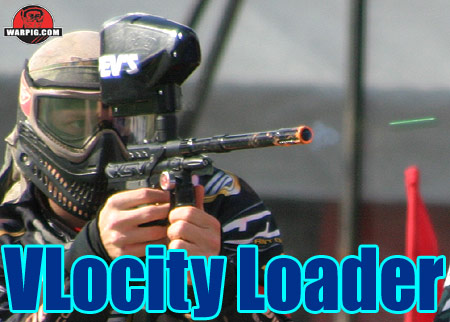  |
|
|
|
|
|
|
  |
|
|
|
|
|
|

What
do you think?
|

VLocity By Bill Mills - Photos by Dawn Mills - April 2006 In the 1990s ViewLoader dominated the world of tournament paintball. Their electronic agitating loaders were the de-facto standard. The VL2000, and its successor the Revolution utilized an internal motor and stirring paddles to prevent the problem that plagued most hoppers at the time – jams. When light from an infrared LED in the feedneck struck an IR detector on the opposite side, the Revolution recognized that its feedneck was empty, and kicked into action, spinning its un-jamming paddles, and stirring up the paintballs inside the hopper, so that more will fall by gravity into the paintgun. The next generation of loader from ViewLoader was the eVLution, and the later, more refined eVLution II. The eVLution took another step forward technologically, in that it allowed the paintballs to fall into a ring shaped raceway in its bottom, where they were driven by a motorized impeller to the feedneck. This move forward in design jumped from simply unjamming paint to sorting it into a line for the feedneck. Like the Revy before it, the eVLution loaders used an infrared break-bean detector in the feedneck with a circuit designed to activate the motor when a gap was detected in the stack of paintballs waiting in the feedneck.
The VLocity represents ViewLoader’s next step forward in loader technology, providing for true force-feeding where pressure from the loader drives paintballs into the paintgun’s breech without having to wait for an empty space to appear in the feedneck. The software driving the Vlocity even allows the user to adjust the amount of force applied to the feed stack, from low pressure for dealing gently with brittle paint to high pressure for maximum speed.
Inside the battery compartment is a clip for a pair of 9-volt batteries. Frayed wires and broken solder connections were among the most common problems facing the original VL 2000 electronic loaders. These were eliminated with the use of spring style clips in the Revolution and eVLution loaders.
The feedneck of the VLocity has some additional significant design features. Most noticeable that it is molded as a single piece, rather than two separate parts like the feednecks of most hoppers.
Because the VLocity does not depend on a gap between the paintballs for activation like the earlier eVLution models did, it is able to operate with a noticeably shorter feedneck. Including its 1-1/2 inch feedneck, the VLocity stands seven inches tall and seven and a half inches long.
Centered in its raceway is the VLocity’s 3-piece impeller. The bottom piece of the impeller is a disk, which connects to the loader’s gear train. Riding atop that piece is the impeller itself. Three arms extend from the center into the raceway to drive paintballs out of the loader. A ring of bumps also serve to bounce and jostle paintballs, stirring them into the raceway. Atop the impeller assembly is a cone, which uses gravity to direct paintballs from the impeller’s center out into the raceway.
The motor drive plugs into the VLocity’s circuit board. Because it is not wired permanently to the board, swapping out a motor drive assembly is an easier task during maintenance or repair. The circuit board itself is a source of more innovations.
The VLocity’s internal software features eight user selectable performance levels, which could best be described as aggressiveness levels. A steel toggle switch on the back of the loader turns it on and off. To the right of the switch is a status LED, and to the left is a tension control push button. While the loader is on, and operating normally, the LED lights green. Holding down the tension control button causes the LED to blink orange. The number of times it blinks indicates the tension mode level, from 1 to 8.
As the tension level setting is increased, the VLocity puts greater amounts of tension on the spring inside the impeller assembly by pulsing greater current levels to the motor when needed. At its highest level, the motor can be heard, putting constant pressure on the paintballs leading straight into the paintgun’s breech. Testing of loaders on different paintguns (see Loader Lineup 2) has shown that there is more to maximum loading speeds than just the loader and its software. The design of the paintgun the loader is interacting with will also come into play. While ViewLoader has addressed this to a degree with the adjustable tension, they have also set things in place to allow for further customization.
Also not to be overlooked are the infrared sensor beams which straddle the feedneck. The VLocity’s dual-beam system provides its microprocessor with more data about feed conditions than the single beam used in VL’s earlier models.
Anti-jamming is another feature built into the VLocity software. If the microprocessor’s feedback sensors determine that the feedneck is empty, and the motor is drawing more amperage because it is facing resistance, it kicks the motor into reverse momentarily about the distance of half a paintball’s diameter, to unjam a paintball that might be caught between one of the impeller’s arms and the mouth of the feedneck. |
| Copyright © 1992-2019
Corinthian Media Services. WARPIG's webmasters can be reached through our feedback form. All articles and images are copyrighted and may not be redistributed without the written permission of their original creators and Corinthian Media Services. The WARPIG paintball page is a collection of information and pointers to sources from around the internet and other locations. As such, Corinthian Media Services makes no claims to the trustworthiness or reliability of said information. The information contained in, and referenced by WARPIG, should not be used as a substitute for safety information from trained professionals in the paintball industry. |